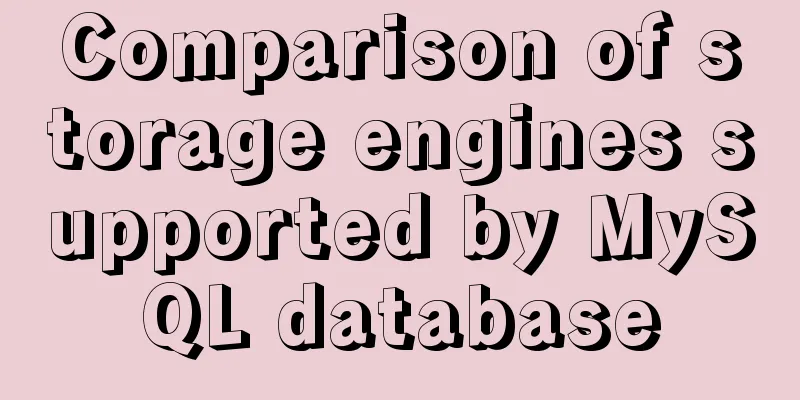Comparison of storage engines supported by MySQL database

Storage Engine MySQL can store data in files (memory) using different techniques, which are called storage engines. Storage engines supported by MySQLMyISAM InnoDB Memory CSV Archive Concurrency ControlEnsure data consistency and integrity when multiple connections modify records. Lock 1. Shared lock (read lock): Multiple users can read the same resource in the same time period, and the data will not change during the reading process. Lock particles 1. Table lock is a lock strategy with the lowest overhead. TransactionsTransactions are used to ensure the integrity of the database
Implementation steps: Foreign KeysIt is a strategy to ensure data consistency. indexIt is a structure for sorting the values of one or more columns in a data table. Features of various storage engines Memory: Data is stored in memory, and the storage limit is limited by the memory size.
MyISAM: The storage limit can reach 256TB, and it supports indexing, table-level locking, and data compression.
The above is the detailed comparison of storage engines supported by MySQL database. For more information about MySQL storage engine, please pay attention to other related articles on 123WORDPRESS.COM! You may also be interested in:
|
<<: Responsive Web Design Learning (2) — Can videos be made responsive?
>>: Detailed explanation of commonly used styles in CSS3 [Basic text and font styles]
Recommend
How to start multiple MySQL databases on a Linux host
Today, let’s talk about how to start four MySQL d...
Nodejs error handling process record
This article takes the connection error ECONNREFU...
JavaScript to implement limited time flash sale function
This article shares the specific code of JavaScri...
Vue implements the right slide-out layer animation
This article example shares the specific code of ...
Example of using JS to determine whether an element is an array
Here are the types of data that can be verified l...
3 solutions to make your website support old versions of IE6, 7, 8, and 9 browsers
Although Microsoft has done a lot of research and ...
Vue two fields joint verification to achieve the password modification function
Table of contents 1. Introduction 2. Solution Imp...
How to write elegant JS code
Table of contents variable Use meaningful and pro...
Implementation of building custom images with Dockerfile
Table of contents Preface Introduction to Dockerf...
Quickly learn MySQL basics
Table of contents Understanding SQL Understanding...
Example of how to build a Harbor public repository with Docker
The previous blog post talked about the Registry ...
MYSQL slow query and log settings and testing
1. Introduction By enabling the slow query log, M...
JavaScript ECharts Usage Explanation
I used ECharts when doing a project before. Today...
Detailed explanation of Vue custom instructions and their use
Table of contents 1. What is a directive? Some co...
How to compile and install PHP and Nginx in Ubuntu environment
This article describes how to compile and install...












